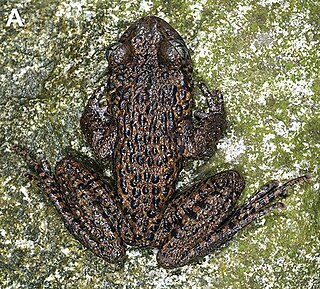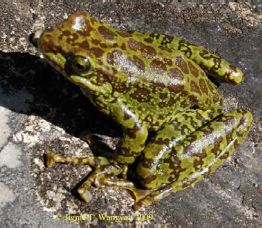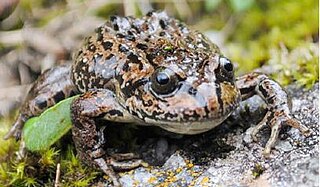
Xenophrys major is a species of toad found in northeastern India, Burma, Thailand, Cambodia, Laos, Vietnam, and southern China. It has recently been reported also from Bhutan.
Boulenophrys wuliangshanensis, commonly known as the Wuliangshan horned toad, is a species of frog found in eastern Asia. It has been found in Yunnan province in China and the state of Nagaland in India and it is thought to occur in Myanmar (Burma), although there are no records from there as yet. Its specific name refers to its type location, Mount Wuliang in Jingdong County.
Leptobrachella alpina is a frog species in the family Megophryidae. It is endemic to Jingdong County in Yunnan, China, where it occurs in Wuliangshan National Nature Reserve; there is also a questionable record from Tianling in Guangxi.
Leptolalax ventripunctatus is a frog species in the family Megophryidae. It is known from Mengla County in Yunnan, southern China, from Phongsaly Province in northern Laos, and from Tam Dao in northern Vietnam. Its natural habitats are subtropical moist lowland forests and rivers. Its status is insufficiently known.

Oreolalax is a genus of amphibian in the family Megophryidae. They are mostly endemic to southwestern China, with one species in northern Vietnam, and possibly extending into adjacent Laos. There is also a population in Arunachal Pradesh that has not yet been assigned to a species, although it might rather be a Scutiger.
Oreolalax granulosus is a species of amphibian in the family Megophryidae. Being restricted to the vicinity of its type locality in Jingdong County in southern Yunnan, where it occurs in Ailaoshan National Nature Reserve. It is endemic to China. Its natural habitats are subtropical moist montane forests and rivers. It is threatened by habitat loss.
Oreolalax jingdongensis is a species of amphibian in the family Megophryidae. It is endemic to China: it is only found in the Ailao Mountains region in Yunnan, including the Jingdong County that has given it its name. Its natural habitats are subtropical or tropical moist montane forests and rivers. It is threatened by habitat loss.
Oreolalax xiangchengensis is a species of amphibian in the family Megophryidae. It is endemic to China where it can be found in western Sichuan and in the Hengduan Mountains in northern Yunnan. Its range includes Baimaxueshan, Habaxueshan, Panzhihua-Sutie, and Yading Nature Reserves.

Xenophrys is a genus of amphibians in the family Megophryidae. They are found in southeastern Asia to Borneo. Their common name is strange-horned toads.
The Jingdong horned toad, or Jingdong spadefoot toad, is a species of frog in the family Megophryidae found in Yunnan and Guangxi, China. It is expected to also occur in northern Vietnam. Its natural habitats are subtropical or tropical moist montane forests and rivers. It is threatened by habitat loss.
The Mangshan horned toad, or Mangshan spadefoot toad, is a species of frog in the family Megophryidae. It is endemic to China and known only from southern Hunan and northern Guangdong; its type locality is Mount Mang (Mangshan) in Yizhang County, Hunan. Its natural habitats are subtropical or tropical moist lowland forests, subtropical or tropical moist montane forests, and rivers. It is threatened by habitat loss.
The Medog horned toad, or Medog spadefoot toad, is a species of frog in the family Megophryidae. It was described as a subspecies of Omei horned toad based on specimens collected from Mêdog County, Tibet (China); it is still only known from its type locality. It probably has a wider distribution that may reach India. Its natural habitats are subtropical or tropical moist lowland forests, subtropical or tropical moist montane forests, and rivers.

The little horned toad, also known as the dwarf horned toad, Kwangshien spadefoot toad, or tiny spadefoot toad, is a species of frog in the family Megophryidae. It is found in southern China, Thailand, Vietnam, and possibly in Laos and Myanmar. It has recently been reported from Bhutan. Its natural habitats are subtropical or tropical moist lowland forests, subtropical or tropical moist montane forests, rivers, and swamps. It is threatened by habitat loss.
The convex-vented horned toad, also known as the Gelin spadefoot toad or Huang's spadefoot toad, is a species of frog in the family Megophryidae. It is found in Tibet (China) and northern Vietnam, and possibly in India. Its natural habitats are subtropical or tropical moist montane forests and rivers.
The Shaping horned toad is a species of frog in the family Megophryidae. It is endemic to China and known only from Sichuan and Yunnan provinces. Its natural habitats are subtropical or tropical moist montane forests, subtropical or tropical high-altitude shrubland, and rivers. It is threatened by habitat loss.
Zhang's horned toad, or Zhang's spadefoot toad, is a species of frog in the family Megophryidae. It was formerly only known from Zhangmu, Nyalam County, Tibet, China, but is now known to be widespread throughout Nepal and also to inhabit four locations in India.

Amolops mantzorum, commonly known as the Sichuan torrent frog or Kangting sucker frog, is a species of frog in the family Ranidae. It is found in Gansu, Sichuan, and Yunnan Provinces of China. It has recently been reported also from Bhutan.

Nanorana pleskei is a species of frog in the family Dicroglossidae. Until recently it has been only known from southwestern/central western China from elevations between 3,300–4,500 m (10,800–14,800 ft), but there is now one record also from Bhutan. Notice, however, that earlier records outside China have turned out to be misidentifications.

Nanorana conaensis is a species of frog in the family Dicroglossidae. Its name refers to its type locality, Mama in Cona County in Tibet. Note that while large parts of Cona County are located within Arunachal Pradesh in the area that is controlled by India but claimed by China, Mama is on the Tibetan side of the border. It has recently been reported also from Bhutan. Its natural habitats are subtropical moist montane forest, high-altitude shrubland, and rivers.
Odorrana jingdongensis is a species of frogs in the family Ranidae. It is known from southern China and northern Vietnam, though it quite likely also occurs in the adjacent areas in Laos and in Myanmar. Its name refers to its type locality, Jingdong Yi Autonomous County in Yunnan. Common name Jingdong frog has been coined for it.








